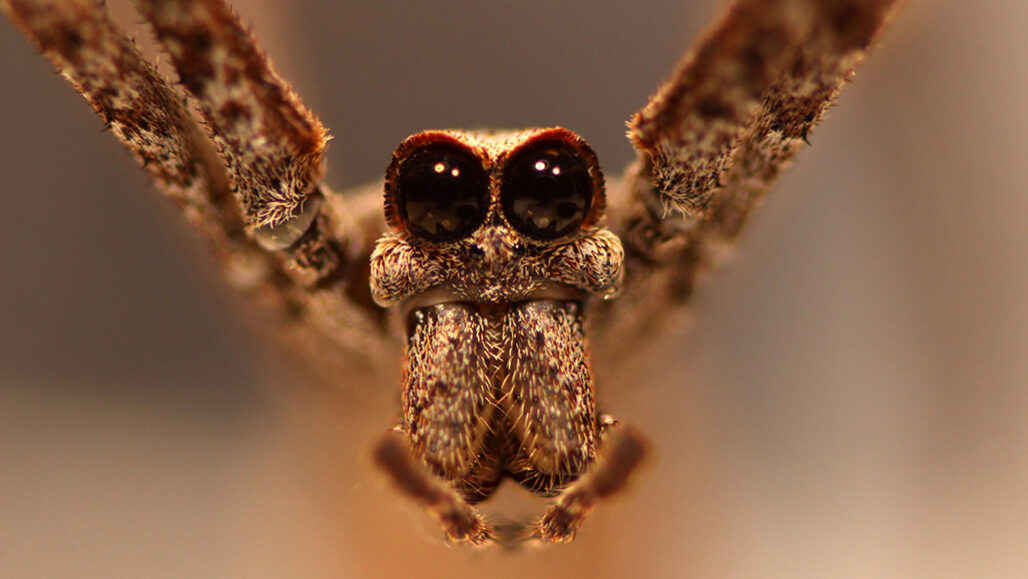Ogre-faced spiders listen closely to snatch bugs from the air
The hunters listen to a range of sounds, but only some trigger an attack

Ogre-faced spiders use their massive eyes to spot food on the ground. For airborne prey, the arachnids also use sound-sensitive organs on their legs.
J. Stafstrom
Some spiders wait for prey to come and tickle their web. But the ogre-faced spider uses its hearing to take that web to its prey.
Hanging upside down, the spider weaves a web between its legs. When an insect flies behind the spider’s back, the spider swings backward. Then, it casts the web toward the prey. This behind-the-back hunting is one clue that this spider (Deinopis spinosa) can hear a wide range of sounds. Researchers shared the finding online October 29 in Current Biology.
“A couple years ago, we didn’t really have a great idea that spiders could hear,” says Jay Stafstrom. Working at Cornell University in Ithaca, N.Y., he studies how spiders sense their surroundings. He is part of a team that has looked at several spider species. Most can hear using specialized organs on their legs, he says. Jumping spiders, for example, react to low-pitched sounds. Stafstrom recently discovered that ogre-faced spiders can hear both low- and high-pitched sounds.
The researchers inserted tiny wires into the brains of 13 ogre-faced spiders. The scientists then played tones of varying pitches from a speaker. By monitoring the spiders’ brain activity, the scientists learned which sounds the spiders could hear. Spikes of brain activity showed that the spiders can sense certain airborne sounds between 100 and 10,000 hertz. (Humans generally hear between 20 Hz and 20,000 Hz.)
Spiders don’t have ears, as humans do. Instead, they have an organ that responds to sound vibrations. It’s called the slit sensilla. So the scientists also tested individual spider legs, because they expected that the spiders were using their legs to hear. Nerve cells in amputated spider legs responded to the wide range of frequencies. This confirmed the spiders hear with their legs, the researchers now say.
Beyond the lab
To test how the spiders would respond to hearing sounds in the wild, the scientists took their speaker to part of the spiders’ natural range. This was in Gainesville, Fla. There, they found 25 of the dangling hunters waiting for prey in the dark. Of these, 13 reacted to frequencies of 150, 400 or 750 Hz. And each reacted in the same way — with a blind, backward strike.
“They can obviously catch things out of the air just using sound,” Stafstrom says. Because the spiders strike only at low frequencies, they’re probably using the lower end of their hearing to listen for prey and hunt. They don’t seem to be using the upper-frequency range to catch food, he says.
Still, the fact that the spiders can detect higher frequencies suggests these sounds are important to them, says Jayne Yack in Ontario, Canada. Working at Carleton University in Ottawa, she studies how animal nervous systems. Yack wasn’t involved in the research. But the spiders may use their hearing for a range of things, she says, such as eavesdropping on predators.
In fact, those higher frequencies fall in a range that predators, including birds, make as they move or call. It makes sense for spiders to listen for those frequencies, says Damian Elias. He’s a biologist at the University of California, Berkeley who wasn’t involved in the study. Brains of the ogre-faced spider clearly picked up the higher frequencies, yet the spiders didn’t react. So the next step could be designing an experiment to learn when the spiders respond to those higher sounds, Elias says. But that might be tricky. Unlike web slinging, the reaction to hearing a predator’s high frequencies may simply be to stay put and hide.
For now, Jay Stafstrom says he’ll just keep shouting whenever he looks for spiders in the field. Maybe they’ll hear him.







